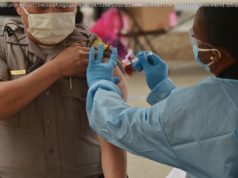Tim Don, the world-record holder in the Ironman triathlon, broke his neck in October. He decided a return to competition was his only option.
BOULDER, Colo. — The world-record holder in the Ironman triathlon had what is known as a hangman’s fracture, a broken C2 vertebra, like that found in someone who has died by hanging.
His doctor laid out his options: A hard collar would let the bones mend on their own, but was inadvisable because of the fracture’s severity. Surgery would fuse the vertebrae, promising a quick fix and a comfortable recovery, but it would limit his neck’s range of motion, ending his athletic career. Or he could have a halo.
“The halo is like a medieval torture device,” the doctor said. “It’s a miserable experience, but it’s the best option for a complete recovery with no limitations in the long run. You take titanium pins and screw them into your skull, two in front and two in back, and attach them to metal bars, which attach to a bust that you wear for three months and that you can’t take off. It’s pure torture. But it works.”
The Ironman athlete opted for the halo, and it was, indeed, pure torture. And it worked. Six months after the pins were screwed into his skull, he will compete on Monday in the Boston Marathon. He expects to finish in about 2 hours 50 minutes — about the same time he ran last May when he set the Ironman world record, 7:40:23, which included five hours of swimming and biking beforehand.
[ ALSO READ: Desiree Linden and Yuki Kawauchi Pull Off Boston Marathon Upsets]
The story of Tim Don, the Ironman king and Boston Marathon runner, is in many ways the embodiment of elite endurance athletes. At age 40, Don has a finite window for his body to withstand peak performance. There is the looming need to support himself through sponsors, who tend to compensate wins, not effort. And aside from childhood jobs as a paperboy and a lifeguard, he has single-mindedly devoted his life to reaching the pinnacle of his sport.
“If you’re a surgeon and someone runs over your hand, you’re still going to try to get back,” he said. “I’ve never had another job, and this sport is my way of life. I don’t know any other way.”
In October, Don was preparing for the Ironman world championship in Kailua-Kona, Hawaii, and went out for his final prerace bike ride. He was warming up when a car smashed into him on the highway.
Instead of the career-defining medal he had sought, Don wound up with the halo. For three months, he passed much of his time motionless in an armchair as his vertebra healed at his home here. He could not dress, shave or shower. His forehead swelled, and the holes where the pins were screwed in began to ooze. When his wife tried to clean around the metal with a sponge, Don nearly passed out from the pain.
He recently said that a return to competition was his only option.
“If I’m going to recover, I’m going to bloody recover,” he said. “I’m going to push the boundaries and come back as soon as I can, as best I can, and try to be even better than before. Why not?”
The accident interrupted a career of two decades. Don grew up in Teddington, England, a wellspring of top endurance athletes near London. (His father was the head of Premier League referees, and officiated the 1994 World Cup.) He loved swimming as a child and started running with local talent, including Mo Farah, the eventual British Olympic distance running champion.
Don competed in his first Olympics in 2000 and went on to race in two more. In 2006, he won the world triathlon championship at the Olympic distance. (He also received a three-month suspension in 2006 for violating antidoping rules, having missed three visits from doping officers. He attributed the absences to careless scheduling mistakes.)
By 2014, he had upgraded to the Ironman, a grueling race of a 2.4-mile swim, a 112-mile bike ride and a marathon on foot.
His big breakthrough finally came last year. He won five of six races, and on May 28, in ideal conditions at Ironman Brazil, he beat the world record for an Ironman-branded race by four minutes.
But on Oct. 11, as Don cycled two days before the Ironman world championship, a utility vehicle made a hasty turn into a gas station and struck him in the side.
“I saw it, and then 20 minutes later, I woke up,” Don said. “I thought I just had whiplash. I wouldn’t take morphine, telling everyone, ‘No, I’m going to race, I’m going to race.’ ”
Then the tests came back.
“He basically had the equivalent of a hangman’s fracture,” said his doctor in Boulder, Alan Villavicencio, also an Ironman competitor. “So he’s lucky he didn’t die because, just like when you get hung, with this injury you can stop breathing.”
After the halo was installed, Don was immobile and vomiting from painkillers at home. “Just try throwing up with one of those things screwed into your head,” he said. “I was telling my wife I was going into the garage and getting an Allen wrench to tear it out.”
For three weeks, he was upright in a chair in a corner of his living room, unable to sleep for more than 90 minutes at a time. His entire right side was black from bruising and swelling. Blood drained to his ankles, swelling them through their compression socks.
His wife, Kelly, became caretaker to her husband along with their two young children. “I think at first it was me that struggled more than Tim,” she said. “We as a family sacrificed so much to get him to the starting line at Kona. These opportunities don’t come often.”
But as he weaned himself off the painkillers, Don was determined to move beyond the confines of his metal halo to fight for a competitive comeback.
Don rationalized his plan: “Most things we do regularly in endurance sports — training 25 hours a week, the sessions at altitude, high performance training — in general is not a healthy pursuit,” he said. “If I was 35, I might say, we can have a dark year. But I’ve only got one or two bites at the cherry.”
So he called his physical therapist.
John Dennis, an amateur triathlete who had treated Don as part of the British Olympic triathlon team and became a friend, flew over in November from Britain to supervise.
“It’s rare for people to break their neck and try to stay at an athletic level,” Dennis said. “If he was just a regular Joe, you wouldn’t need to worry about anything other than the neck, but we wanted to give him the best chance to come back quickly. So we had to think outside the box and focus not on his limitations but on what he could do.”
They improvised a plan. While Don was still in the halo, they worked on strengthening his lower body. Soon, he was painstakingly using an exercise bike, taking care not to lean forward and overload his neck. He wound up doing more overall core conditioning work than he’d ever done in his career.
Then Don began to push, in the gym every day, at one point in December fainting during a training session when the halo’s screws put too much pressure on his skull.






